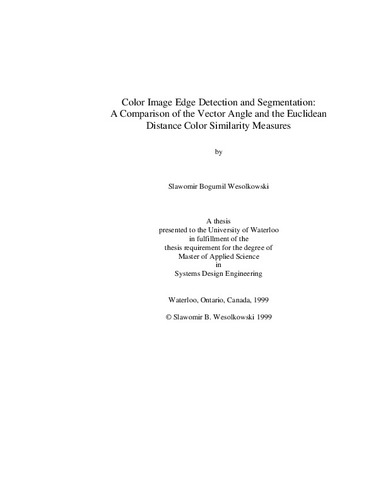Color Image Edge Detection and Segmentation: A Comparison of the Vector Angle and the Euclidean Distance Color Similarity Measures
Abstract
This work is based on Shafer's Dichromatic Reflection Model as applied to color image formation. The color spaces RGB, XYZ, CIELAB, CIELUV, rgb, l1l2l3, and the new h1h2h3 color space are discussed from this perspective. Two color similarity measures are studied: the Euclidean distance and the vector angle. The work in this thesis is motivated from a practical point of view by several shortcomings of current methods. The first problem is the inability of all known methods to properly segment objects from the background without interference from object shadows and highlights. The second shortcoming is the non-examination of the vector angle as a distance measure that is capable of directly evaluating hue similarity without considering intensity especially in RGB. Finally, there is inadequate research on the combination of hue- and intensity-based similarity measures to improve color similarity calculations given the advantages of each color distance measure. These distance measures were used for two image understanding tasks: edge detection, and one strategy for color image segmentation, namely color clustering. Edge detection algorithms using Euclidean distance and vector angle similarity measures as well as their combinations were examined. The list of algorithms is comprised of the modified Roberts operator, the Sobel operator, the Canny operator, the vector gradient operator, and the 3x3 difference vector operator. Pratt's Figure of Merit is used for a quantitative comparison of edge detection results. Color clustering was examined using the k-means (based on the Euclidean distance) and Mixture of Principal Components (based on the vector angle) algorithms. A new quantitative image segmentation evaluation procedure is introduced to assess the performance of both algorithms. Quantitative and qualitative results on many color images (artificial, staged scenes and natural scene images) indicate good edge detection performance using a vector version of the Sobel operator on the h1h2h3 color space. The results using combined hue- and intensity-based difference measures show a slight improvement qualitatively and over using each measure independently in RGB. Quantitative and qualitative results for image segmentation on the same set of images suggest that the best image segmentation results are obtained using the Mixture of Principal Components algorithm on the RGB, XYZ and rgb color spaces. Finally, poor color clustering results in the h1h2h3 color space suggest that some assumptions in deriving a simplified version of the Dichromatic Reflectance Model might have been violated.
Collections
Cite this version of the work
Slawomir Bogumil Wesolkowski
(1999).
Color Image Edge Detection and Segmentation: A Comparison of the Vector Angle and the Euclidean Distance Color Similarity Measures. UWSpace.
http://hdl.handle.net/10012/937
Other formats
Related items
Showing items related by title, author, creator and subject.
-
Algebraic Analysis of Vertex-Distinguishing Edge-Colorings
Clark, David (University of Waterloo, 2006)Vertex-distinguishing edge-colorings (vdec colorings) are a restriction of proper edge-colorings. These special colorings require that the sets of edge colors incident to every vertex be distinct. This is a relatively ... -
List Coloring Some Classes of 1-Planar Graphs
Barr, Sam (University of Waterloo, 2021-12-23)In list coloring we are given a graph G and a list assignment for G which assigns to each vertex of G a list of possible colors. We wish to find a coloring of the vertices of G such that each vertex uses a color from its ... -
Radiometric Compensation of Nonlinear Projector Camera Systems by Modeling Human Visual Systems
Post, Matthew (University of Waterloo, 2023-04-21)Radiometric compensation is the process of adjusting the luminance and colour output of images on a display to compensate for non-uniformity of the display. In the case of projector-camera systems, this non-uniformity can ...

